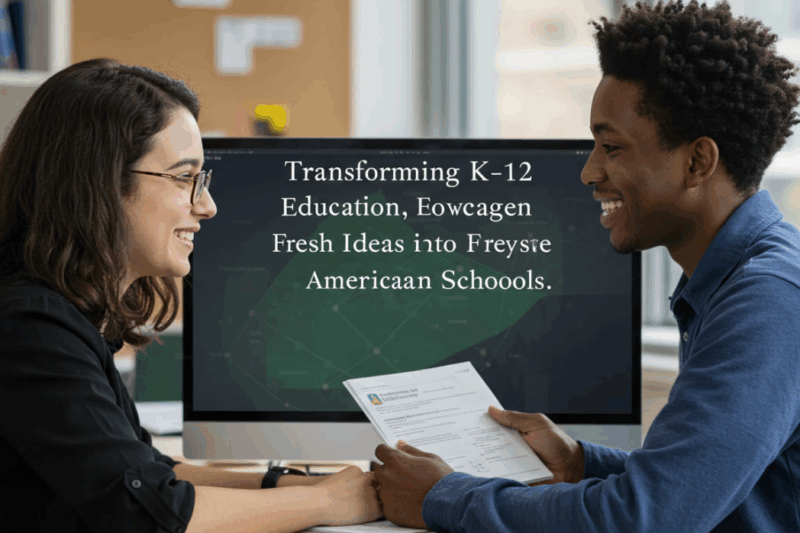The United States has long prided itself on being a land of opportunity, yet its education system often falls short of delivering equal access to quality learning for all students. The education gap—also known as the opportunity gap—reflects systemic disparities in resources, opportunities, and outcomes that disproportionately affect students in underserved communities. Factors such as inadequate school funding, limited access to advanced coursework, and socioeconomic challenges create barriers that prevent millions of children from reaching their full potential. This article explores the root causes of the education gap, evaluates innovative solutions, and highlights actionable steps to promote educational equity in US schools, ensuring every student has a fair shot at success.
Understanding the Education Gap
What Is the Education Gap?
The education gap refers to the persistent disparities in academic performance and opportunities between students from different socioeconomic, racial, and geographic backgrounds. In the US, this gap manifests in lower graduation rates, reduced access to advanced placement (AP) courses, and significant differences in standardized test scores. For instance, students in underserved communities—often from low-income families or minority groups—are less likely to attend well-funded schools with experienced teachers or access to modern technology. According to the National Center for Education Statistics, high-poverty schools have graduation rates as low as 68%, compared to 86% in low-poverty schools. These statistics underscore the urgent need to address systemic inequities.
The Role of School Funding
School funding is a cornerstone of the education gap. In the US, public schools are primarily funded through local property taxes, which creates a vicious cycle: wealthier neighborhoods with higher property values generate more revenue for schools, while low-income areas struggle to provide adequate resources. This results in underfunded schools in underserved communities, where students face outdated textbooks, crumbling infrastructure, and fewer extracurricular opportunities. A 2019 report from EdBuild found that school districts serving predominantly students of color received $23 billion less in annual funding than predominantly white districts, despite serving similar numbers of students. This funding disparity perpetuates the opportunity gap, limiting access to quality education.
Innovative Solutions for Educational Equity
Reforming School Funding Models
To bridge the education gap, reforming how schools are funded is critical. States can adopt equitable funding formulas that prioritize need over property wealth. For example, weighted student funding allocates resources based on specific student needs, such as poverty levels, English language proficiency, or special education requirements. States like California have implemented the Local Control Funding Formula (LCFF), which directs additional funds to districts with high populations of underserved students. This approach has shown promise, with early data indicating improved graduation rates and academic performance in targeted districts. By redistributing resources more equitably, schools can hire qualified teachers, upgrade facilities, and provide enrichment programs that level the playing field.

Expanding Access to Technology
Technology can be a game-changer in closing the opportunity gap, particularly in underserved communities. The COVID-19 pandemic exposed the digital divide, with millions of students lacking access to reliable internet or devices for remote learning. Initiatives like the federal E-Rate program, which subsidizes internet access for schools and libraries, have made strides in addressing this issue. Additionally, partnerships with private organizations can provide laptops, tablets, and software to students in need. For example, programs like One Laptop per Child have successfully equipped students in low-income areas with tools to engage in digital learning. By ensuring all students have access to technology, schools can offer personalized learning experiences and prepare students for a tech-driven world.
Teacher Training and Retention
High-quality teachers are essential for educational equity, yet underserved schools often struggle to attract and retain experienced educators. Investing in teacher training programs that focus on culturally responsive teaching can empower educators to better serve diverse student populations. Additionally, offering incentives such as loan forgiveness, higher salaries, or professional development opportunities can attract talented teachers to high-need schools. For instance, the Teach for America program places committed educators in underserved communities, with participants often staying beyond their initial commitment. Retaining skilled teachers ensures that students receive consistent, high-quality instruction, which is crucial for closing the achievement gap.
Community and Policy Engagement
Empowering Underserved Communities
Communities play a vital role in advocating for educational equity. Grassroots organizations, parent associations, and local leaders can push for policy changes that address systemic inequities. Community-driven initiatives, such as after-school programs and mentorship opportunities, provide students with additional support outside the classroom. For example, the Harlem Children’s Zone in New York City offers comprehensive services, from early childhood education to college prep, resulting in significantly higher graduation rates for participants. By fostering community involvement, schools can create a supportive ecosystem that uplifts students and families.
Policy Advocacy for Systemic Change
Policy changes at the state and federal levels are essential for sustainable progress. Lawmakers must prioritize legislation that addresses funding disparities, expands access to early childhood education, and supports teacher diversity. The Every Student Succeeds Act (ESSA) of 2015, for instance, emphasizes accountability for underserved student groups and encourages states to develop plans for equitable education. Advocacy groups like the Education Trust work to ensure that policies prioritize low-income students and students of color. By holding policymakers accountable, advocates can drive systemic change that benefits all students.
Inspirational Quotes on Educational Equity
To inspire action, here are some powerful quotes from leaders in education and social justice:
“Education is the most powerful weapon which you can use to change the world.” – Nelson Mandela
“The function of education is to teach one to think intensively and to think critically. Intelligence plus character—that is the goal of true education.” – Martin Luther King Jr.
“Equity in education is not about equal treatment; it’s about giving every student what they need to succeed.” – Linda Darling-Hammond
These quotes remind us that education is a fundamental right and a catalyst for social change. By prioritizing equity, we can unlock the potential of every student and build a more just society.
The Path Forward
Bridging the education gap requires a multifaceted approach that combines innovative funding models, technology access, teacher support, and community engagement. While challenges remain, the success of programs like California’s LCFF and the Harlem Children’s Zone demonstrates that progress is possible with concerted effort. By investing in equitable education, the US can ensure that every child, regardless of background, has the opportunity to thrive. The time to act is now—every step toward equity is a step toward a brighter future for all.
FAQ
What is the education gap?
The education gap, or opportunity gap, refers to disparities in academic outcomes and access to quality education between students from different socioeconomic, racial, or geographic backgrounds.
How does school funding affect educational equity?
School funding in the US often relies on local property taxes, leading to disparities where wealthier areas have better-funded schools. Equitable funding models can help ensure all schools have adequate resources.
What role does technology play in closing the education gap?
Technology provides access to digital learning tools and personalized education, helping students in underserved communities overcome resource limitations and prepare for modern careers.
How can communities support educational equity?
Communities can advocate for policy changes, support after-school programs, and engage in mentorship initiatives to provide additional resources and encouragement for students.
What are some successful programs addressing the education gap?
Programs like California’s Local Control Funding Formula, the Harlem Children’s Zone, and Teach for America have shown success in improving outcomes for underserved students through targeted interventions.



